Restarting Breakfast
INGREDIENTS
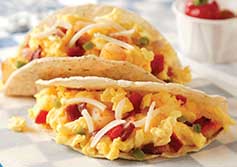 Within moments of waking each morning, as your senses enliven, your attention turns to a question etched into your subconscious mind since childhood: What’s for breakfast? Perhaps in your childhood, breakfast was routine: a bowl of cereal, pancakes, or eggs prepared especially for you by a caring adult. Those were the good old mornings, you might think to yourself, but who has the time for breakfast these days? Times have changed. The world is more hectic, complicated. Besides, you’ve gained a few pounds (not to mention cholesterol points) and could do without the extra calories from fat and sugar that are present in typical breakfast foods.
Within moments of waking each morning, as your senses enliven, your attention turns to a question etched into your subconscious mind since childhood: What’s for breakfast? Perhaps in your childhood, breakfast was routine: a bowl of cereal, pancakes, or eggs prepared especially for you by a caring adult. Those were the good old mornings, you might think to yourself, but who has the time for breakfast these days? Times have changed. The world is more hectic, complicated. Besides, you’ve gained a few pounds (not to mention cholesterol points) and could do without the extra calories from fat and sugar that are present in typical breakfast foods.
‘Tis the season for breakfast skipping. Take a look around any airport between the hours of 5 a.m. and 9 a.m., especially around this time of year, and you’ll notice that travelers have far more on their minds than getting in their “most important meal of the day.” If you were to casually ask travelers—say, ones waiting for an early flight out of Orlando, Fla.— what they’d had for breakfast that morning, you’ll find that their excuses for skipping vary, but most can be summarized as one of the following: “I don’t have time for breakfast,” “breakfast slows me down,” or “I’m watching my diet.” These reasons for skipping breakfast aren’t unique to airport travelers. According to National Health and Nutrition Examination Surveys (NHANES) data, breakfast has been in decline for over half a century. The number of breakfast skippers has increased to nearly 20% among Americans adults and children (over age 2) alike, compared to only 14% in 1965. In addition, nearly 32% of adolescents (ages 13 to 19) skip breakfast regularly.
It’s a trend that concerns nutritionists like Heather Leidy, an Assistant Professor of Nutrition and Exercise Physiology at the University of Missouri School of Medicine. Recently, Leidy led a trial comparing 20 overweight or obese late-adolescent girls who regularly skipped breakfast with either a group that ate a breakfast (~350 Kcals) with 15 g of protein or one with 35 g of protein. The study evaluated breakfast’s influence on control of food intake through measurement of appetite, hormonal, and neural signals and found that eating breakfast led to changes related to decreased feelings of hunger and greater satiety, or feelings of fullness throughout the day. Breakfast also reduced activity in the brains of the teen girls related to food motivation and reward, which led to a decreased desire to eat and fewer calories eaten over the course of the day. In addition, the girls who ate breakfasts higher in protein were also less likely to snack in the evening, particularly on high-fat foods, although no difference in intake of calories was noted between the two groups.
Leidy also noted that eating breakfast improved overall diet quality in the teen girls. The finding is of particular importance in that this population is at high risk for inadequate intake of folic acid, calcium, and vitamin D. Children and teens who skip breakfast present a serious concern because they often miss a range of essential vitamins and minerals that are typically provided by breakfast foods such as cereal, dairy, and eggs. Findings from NHANES data from 1999 to 2006 suggest that American children (ages 9 to 13 years) who eat fortified breakfast cereal regularly receive 49% more iron and 55% more vitamin A than breakfast skippers. Those children are also more likely to meet recommended intakes for vitamin D and B vitamins (folic acid, riboflavin, and vitamin B-12). According to Leidy’s research, children who eat breakfast are also more attentive in the classroom, more likely to have better behavior, and score higher on tests in subjects such as math.
A study Leidy conducted with Kevin C. Maki, a research scientist with Biofortis Clinical Research, also found appetite-control benefits for women ages 18 to 55 who consumed a high-protein sausage and egg-based breakfast compared with those who had either a low-protein breakfast (pancakes and syrup) or who skipped breakfast. Those who consumed the high-protein breakfasts (30–39 g of protein) reported less hunger and desire to eat throughout the morning and had fewer calories at lunch compared with women in the other two groups. Findings from the study, which was funded by Hillshire Brands, Chicago, Ill. (www.hillshirebrands.com), and titled “Acute Satiety Effects of Sausage/Egg-based Convenience Breakfast Meals in Premenopausal Women,” were presented at the Obesity Society’s annual scientific meeting last month.
What can be done to reverse the increasing trend of breakfast skipping? Food scientists and technologists are finding creative and innovative ways to meet the needs of consumers who are looking for more on-the-go options and healthier fare in this important category. Consider that, according to NHANES data, more than 25% of U.S. adult breakfast-eaters consume the meal away from home. Breakfast also reigns as the projected fastest-growing eating occasion, NPD Group reports, with sales of foods eaten during the breakfast occasion estimated to be approximately $208 billion and growing. Mintel reports, in addition, that the breakfast category is expected to grow nearly 26% by 2017. So there’s your wake-up call— breakfast is coming back, and it’s changing to be more portable, more satisfying, and more nutritious.
--- PAGE BREAK ---
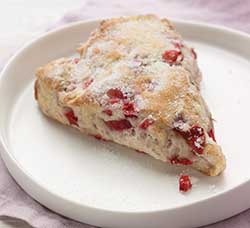 The Rise of Greek Yogurt
The Rise of Greek Yogurt
Back at the Orlando airport, Shari Jones, a sales clerk at Cibo Market, has a few recommendations for a quick and nutritious breakfast. Topping her list is Chobani™ Flip Low-Fat Greek Yogurt. “I’ve tried all of the flavors,” she says, but she has a special preference for Almond Coco Loco. Why? Because of its toasted almonds and dark chocolate chips, of course, she says. With only 230 calories, 12 g of protein, 80 mg of sodium, and 15% Daily Value of calcium, what’s not to like? Jones is far from alone in making yogurt a morning favorite. Greg Miller, President of the Dairy Research Institute, calls yogurt a “standout category” for breakfast eating with “nearly 300% growth in consumption in the last decade and a continued strong outlook.”
Yogurt’s success, he says, is thanks to innovation and targeting key consumer desires that include “digestive health, immunity, protein, and convenient or portable packaging.”
John Heath, Senior Vice President of Innovation at Chobani, New York , N.Y. (www.chobani.com), says that the Greek yogurt segment now accounts for 48% of all yogurt sales in the United States, up from less than 1% when Chobani sold its first case of yogurt in 2007. Earlier this year, Chobani introduced its line of Flip Greek Yogurts (including Almond Coco Loco), which are a convenient pairing of strained Greek yogurt and mix-ins. The products, Heath says, come with “mix-ins ranging from trending ingredients such as chia seeds, toasted coconut, and roasted salted almonds to the more traditional toppings such as crunchy granola and honey oats.” Chobani is only just getting started tapping into the breakfast market in the United States, Heath says; after all, Europeans eat six to seven times more yogurt than Americans on a daily basis. In addition to serving as a thick and creamy base for breakfast parfaits and smoothie recipes, Heath says, the yogurt can be incorporated into traditional breakfast items like muffins, scones, French toast, and pancakes to help lower fat, calories, and sodium while increasing protein.
According to Miller, you can expect to see more ingredient-focused uses for yogurt in traditional foods, such as waffles made with yogurt. “Plus we’re seeing an increasing amount of location-inspired yogurts,” he adds. International options now include Icelandic-style skyr and Australian-style options such as Noosa brand yogurt (www.noosayoghurt.com). Additionally, Eastern European favorite kefir is gaining popularity. Kefir as well as frappes can offer consumers both portability as well as benefits associated with a higher protein intake such as satiety. Following yogurt’s lead, Miller envisions, will be other dairy ingredients. “The quest is on to identify options with even higher protein levels than Greek yogurt.”
Following Yogurt’s Lead—Dairy Proteins
Nearly half (45%) of consumers are seeking out foods that are high in protein, “for many good reasons,” according to Kara McDonald, Director, U.S. Ingredients Marketing & Communications for U.S. Dairy Export Council. “Protein is an essential daily nutrient. It plays many important roles, such as repairing the body’s cells, building and repairing muscles, helping build and maintain bones, and helping control many metabolic processes.”
Smoothies or frappes are an ideal way to get dairy protein or yogurt combined with other ingredients such as fruit, according to McDonald. She says, “The popularity of these breakfast beverages has prompted the food industry to offer them in a variety of formats including shelf-stable, refrigerated, or frozen.” These different formats also are spurring development in other areas such as fruit ingredients, nuts, and grain products for use in breakfast beverages.
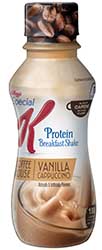 Dairy-based breakfast beverages are causing quite a stir now that cereal giants Kellogg’s Co., Battle Creek, Mich. (www.kelloggs.com), and General Mills, Minneapolis, Minn. (www.generalmills.com), have rolled out their own products. They include Kellogg’s dairy-based Special K Breakfast to Go and Special K Coffee House Breakfast Shakes, which along with rival General Mills BFAST is helping to meet consumers’ needs for nutrition, convenience, taste, and portability. Quaker Oats Co., Chicago, Ill. (www.QuakerOats.com), a unit of PepsiCo Inc., Purchase, N.Y. (www.PepsiCo.com), also looks to be testing the breakfast beverage market by expanding its brand to include Quaker cereal powder drinks in countries like China and Brazil.
Dairy-based breakfast beverages are causing quite a stir now that cereal giants Kellogg’s Co., Battle Creek, Mich. (www.kelloggs.com), and General Mills, Minneapolis, Minn. (www.generalmills.com), have rolled out their own products. They include Kellogg’s dairy-based Special K Breakfast to Go and Special K Coffee House Breakfast Shakes, which along with rival General Mills BFAST is helping to meet consumers’ needs for nutrition, convenience, taste, and portability. Quaker Oats Co., Chicago, Ill. (www.QuakerOats.com), a unit of PepsiCo Inc., Purchase, N.Y. (www.PepsiCo.com), also looks to be testing the breakfast beverage market by expanding its brand to include Quaker cereal powder drinks in countries like China and Brazil.
In terms of versatility, dairy proteins are hard to beat, which is why they can be added to a quite the variety of breakfast foods. McDonald predicts that—apart from breakfast beverages—dairy proteins (e.g., whey) will be incorporated into a variety of grain-based breakfast products, including bars, cereals, oatmeal, waffles, and bagels. A combination of dairy protein, nuts, and whey crisps can also yield crunchy breakfast treats, she says. Bakery mixes, such as fresh pancakes or muffins, could also benefit from the boost of quality protein.
In July, The Dairy Research Institute’s New Product Competition focused on innovating new breakfast products. The winner, Mooofins, is a portable dairy-based, quiche-like muffin developed for adults seeking a high-protein, on-the-go breakfast option by a team of food science students at Pennsylvania State University. Formerly a Nittany Lion himself, Miller says, “Mooofins provide consumers convenience through portability, satiety benefits due to higher protein and favorite tastes, serving as a great example of how products need to fuse benefits to maximize the future breakfast market opportunity.”
Dairy proteins can also be used in formulations that address concerns surrounding the generation of “acid whey” in Greek yogurt production. For all of yogurt’s strong growth as a category, especially Greek yogurt, it has brought with it concerns over effects on the environment and sustainability because of the production of “acid whey” as a byproduct of manufacturing. According to Torben Jensen, application manager at Arla Foods Ingredients, Sønderhøj, Denmark (www.arlafoodsingredients.com), Nutrilac® proteins for Greek-style yogurt are manufactured using a technique that eliminates the need for the whey separation step that leads to the production of “acid whey” in traditional Greek yogurt making. “That means that virtually 100% of the milk used in the manufacturing process ends up in the final product,” he says. Nutrilac proteins promise to enable yogurt manufacturers to completely eliminate acid whey in the production of their Greek or Greek-style yogurt without compromising quality or taste of the final product. The ingredient itself need only be declared as “milk protein” on the packaging label.
--- PAGE BREAK ---
Fruit Fortified
Fruit ingredients have long been part of breakfast foods, whether found in dry mixes such as muesli, oatmeal, or cereal, in baked goods such as muffins or bagels, or in yogurt and smoothies. Fruit ingredients can improve the appeal of nearly any breakfast food with a boost to flavor and color. In addition, they add nutritional value that can command premiums among health-conscious consumers. Now, new developments such as those in freeze-drying and pasteurization promise to help bring more shelf-stable fruit ingredients to packaged formulations.
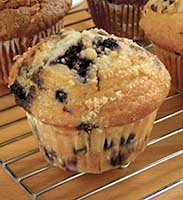 Blueberries and blackberries, for example, make regular appearances in breakfast foods including pancakes, waffles, and muffins. They are also popular in dairy-based breakfast formulations such as smoothies and yogurts. Thanks to Van Drunen Farms, Momence, Ill. (www.vandrunenfarms.com), blueberry and blackberry flavors can be enjoyed year-round for breakfast. The company’s freeze-dried and low-moisture varieties are ideal for breakfast applications. Freeze-dried blueberries come in whole, sliced, diced, or powdered forms for easy addition into smoothies and drink mixes, yogurts, breakfast bars, pancake mixes, bagels, and other breakfast applications. Low-moisture blackberries have their water replaced with sugar to extend shelf life and are excellent additions to muesli, oatmeal, waffles, pancakes, and yogurt.
Blueberries and blackberries, for example, make regular appearances in breakfast foods including pancakes, waffles, and muffins. They are also popular in dairy-based breakfast formulations such as smoothies and yogurts. Thanks to Van Drunen Farms, Momence, Ill. (www.vandrunenfarms.com), blueberry and blackberry flavors can be enjoyed year-round for breakfast. The company’s freeze-dried and low-moisture varieties are ideal for breakfast applications. Freeze-dried blueberries come in whole, sliced, diced, or powdered forms for easy addition into smoothies and drink mixes, yogurts, breakfast bars, pancake mixes, bagels, and other breakfast applications. Low-moisture blackberries have their water replaced with sugar to extend shelf life and are excellent additions to muesli, oatmeal, waffles, pancakes, and yogurt.
Strawberries are a long-time favorite in yogurts, yet the raw fruits traditionally brought poor stability. According to Doug Webster, Director of Product Development, TreeTop Inc., Selah, Wash. (www.treetop.com), a newly built facility in California now offers pasteurized strawberries. For food manufacturers, that means strawberry flavor with an extended shelf life in yogurts and beverages. The company also offers dried fruit clusters, with a range of 40% to 100% fruit, that can be used in side compartments of packaged yogurts such as those offered in fast food restaurants or like the new Chobani Flip Greek Yogurts.
Cranberries continue to be something of a novelty ingredient in breakfast applications, but they are ideal for their color and flavor. Cranberries also are baking-stable, meaning they don’t release their color into dough during production of baked goods. Now Ocean Spray Ingredient Technology Group, Lakeville-Middleboro, Mass. (www.oceanspray.com), announced that the company is focusing on two product innovations: Sweetened Dried Cranberries (SDC) VeryBerry and BerryFusion (BFF) Pomegranate Wholes. The VeryBerry dried cranberries are described as intense in their flavor, making them suitable for muesli, oatmeal, or cereal bars. The BFF Pomegranate Wholes combine the flavor of cranberry with that of pomegranate as a novelty ingredient with a 24-month shelf life making them also ideal for use in muesli and bars.
Prune dices are another type of fruit ingredient that can be used in a variety of breakfast foods, including savory ones. Available from Sunsweet Growers, Yuba City, Calif. (www.sunsweetingredients.com), prune dices work especially well with milk-based products like yogurts and dairy-based breakfast beverages. In dry mixes like muesli, glycerin can be used as a humectant to prevent the prune dices from drying, hardening, and losing their taste. Because prunes have a high amount of natural sorbitol, prune ingredients can also be used to help reduce the overall content of sugar in a food. Interestingly, it’s this high amount of sorbitol that allows Sunsweet concentrate, made from plums, to serve well as a replacement for phosphates in meats and sausages. Both Sunsweet’s and Ocean Spray’s parent company is Bolasco Import GmbH, a division of the company group Bosch Boden Spies, Hamburg, Germany (www.bolasco.de).
Smaller-scale craft bakeries can look to Taura Natural Ingredients, Winchester, Va. (www.tauraurc.com), for specialty fruit pieces. Taura’s Gourmet Series fruit pieces include strawberry, blueberry, raspberry, orchard fruit, orange, and honey and are specially created for artisanal confectionary and bakery products. The fruit pieces are suitable for a wide range of products including muffins, breads, biscuits, and nutrition bars.
Going Meatless
Egg proteins have also taken on a role in meatless breakfast formulations. Lightlife Foods, Turners Falls, Mass. (www.lightlife.com), recently debuted Chik’n Entrees and Veggie Burgers using egg whites to boost protein content to between 14 g and 20 g per serving, depending on the product. Dr. Praeger’s Sensible Foods, Elmwood Park, N.J. (www.drpraegers.com), is also using egg proteins combined with wheat and soy for its line of meatless sausage-like patties. Each patty supplies only 80 calories, 7 g of protein, and 4 g of unsaturated fat. Typical pork patties have at least double the calories and the fat, a lot of which is saturated.
While the growing market for plant-based protein may have stemmed from consumers who adhere to a vegetarian lifestyle, Josh Tetrick, founder of Hampton Creek Foods, San Francisco, Calif. (www.hamptoncreekfoods. com), is seeking to extend market share for his company’s plant-based egg alternatives by targeting food manufacturers with a product that he says is cheaper than egg and works just as well. The egg substitute is one based on a variety of plant proteins, sorghum, and a type of bean, which is said to deliver the same functionality as eggs.
From Sweet to Savory
Apart from the trend toward more convenient, better-for-you options at breakfast, there’s one thing of which you can be sure. “Consumers are always hungry for more—more flavor, color, and a more intense eating experience in a nontraditional format,” says Ron Heddleson, Director of Technical Services of QualiTech, Chaska, Minn. (www.qualitechco. com). Part of that hunger for more includes a taste for savory or blended sweet and savory inclusions such as Pancake Sausage Bites. “We receive a lot of requests for savory and sweet and salty flavors, including bacon and cheese,” says Heddleson. So the company has introduced several new flavors in the past 12 months, including savory flavors such as natural-flavor bacon, maple bacon, and French toast. Their sweet and savory offerings include caramel sea salt. In addition, they’ve developed a wide range of sweet flavors ranging from the familiar like honey and exotic fruit flavors like açai and mango. Additionally, Heddleson says, “It seems like everyone is striving for simplicity within their ingredient declaration, and the use of natural flavors and colors are a key part of that trend.” Customizing offerings to make simple labels with natural ingredients is one of QualiTech’s core strengths. The company also has a range of flavor profiles for whole-grain items that include Maple Whole Grain, Chocolate Whole Grain, Blueberry Whole Grain, and Strawberry Whole Grain.
--- PAGE BREAK ---
Healthy Bacon and Sausage
Did someone say bacon? Wixon, St. Francis, Wis. (www.wixon.com), has been busy innovating meaty and savory breakfast items. These include Bacon, Egg, and Cheese Sausage Breakfast Stick described as ideal for “on-the-go” and health-conscious appetites. The sticks feature 80% lean pork and are made with real eggs. Wix-Fresh OatMax helps increase moisture retention, shelf life, and overall savory notes while reducing the warmed-over flavor often found in pre-cooked meats. Wix-Fresh Minermax enhances savory notes while masking metallic flavors.
In addition, Wixon’s Country-Style Breakfast flavor gives the stick a traditional taste. The company also offers Wix-Fresh RSS (Reduced Sodium System) for reducing sodium in meat and poultry applications, including pork breakfast sausage. It is fully customizable and provides a positive impact on flavor naturally without compromising functionality. The system is said to generate up to a 50% reduction in sodium without diminishing the flavor.
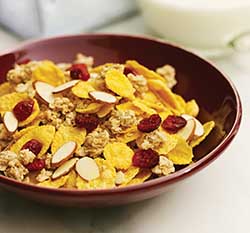 Breakfast Going Nuts
Breakfast Going Nuts
When Shari Jones of Orlando airport said she preferred the nutty flavor of Chobani’s Almond Coco Loco, what she was referring to was the crunch and taste of toasted almonds. Almonds are consistently a favorite at breakfast, and more than half (57%) of Americans think of almonds first when they think of nuts in cereal or granola, according to a 2010 Breakfast Outlook Study commissioned by the Almond Board of California, Modesto, Calif. (www.almondboard.com). In comparison to other types of nuts, almonds are most preferred and most consumed. Two other studies also commissioned by the ABC, found that both men and women envisioned almonds as their No. 1 ingredient in an “ideal cereal.” Moreover, almonds outscore other nuts on attributes that consumers say they are looking for when choosing breakfast foods: “tasty and nutritious” and “fill me up until lunch.” The nutrition of almonds and their effects on satiety are notable with each serving of almonds (28 g), providing 4 g of fiber, 13 g of monounsaturated fats, and 6 g of protein.
Additional evidence of almond’s satiating benefits comes from a study in 2011 published by Richard Mattes of Purdue University in the Journal of Nutrition and Metabolism. The study randomized 14 adults with impaired glucose tolerance to either a high-glycemic-index breakfast that either included almonds or did not. The participants who ate a breakfast with almonds reported feeling fuller longer and showed lower blood sugar concentrations after both breakfast and lunch, as compared with those who only ate the high-glycemic-index breakfast alone. The research found that including a low-glycemic-index food like almonds in a high-glycemic-index breakfast could moderate the rise of blood sugar.
In breakfast applications, almonds offer multi-functionality: visual appeal, crunchy texture, and availability in more forms than almost any other tree nut. These forms include whole natural, blanched, sliced, diced, slivered, chopped, and almond butter. When dairy is not an option, almond milk can be used in breakfast beverages alone or blended with fruit for a delicious drink. Because almonds are also gluten-free, almond flour can also facilitate production of lower-gluten or gluten-free pancakes, waffles, or scones. In addition, almond crème is a new application developed by Chef John Csukor of KOR Food Innovation, Ashland, Virginia (www.korfoodinnovation.com). With a consistency similar to Greek yogurt and a balanced, neutral flavor profile, almond crème works well as a base for a variety of formulations. It’s also made with just two ingredients, blanched almonds and water, so the crème can be cultured for a nondairy yogurt product.
Walnuts also warrant attention because of their nutritional profile. Earlier this year, walnuts had a starring role in findings from the landmark Spanish PREDIMED (PREvención con Dieta MEDiterranea) trial. The study included 7,447 participants at high cardiovascular risk who were followed for 4.8 years. The study randomized the participants to one of three intervention diets: a low-fat diet (control group), a Mediterranean diet supplemented with extra-virgin olive oil (50 ml per day), or a Mediterranean diet supplemented with 30 g of mixed nuts per day (15 g walnuts, 7.5 g almonds, and 7.5 g hazelnuts). The researchers reported that a Mediterranean diet including nuts, primarily walnuts, reduced the risk of cardiovascular diseases by 30% and stroke by 49% when compared to a low-fat diet based on American Heart Association Guidelines. In addition, the study found that the Mediterranean diet supplemented with extra-virgin olive oil also reduced the risk of cardiovascular disease by 30%.
Walnuts can be used in a variety of breakfast applications. Consider breakfast recipes such as those made available by the California Walnut Commission (www.walnuts.org) like apple walnut muffins, banana nut pancakes, banana walnut shakes, cinnamon walnut swirl bagels, and walnut granola. Walnuts can also add nutty flavor and considerable weight to a nutritional profile. Emilio Ros of University of Barcelona, a co-investigator in the PREDIMED study, said that walnuts were likely to have been key in contributing cardiovascular protection in the study because of their content of numerous antioxidants and alpha-linolenic acid, a plant-based omega-3 fatty acid.
--- PAGE BREAK ---
Rebirth of Eggs
When it comes to nutrition, the incredible egg is the complete package. Eggs provide 6 g of high-quality protein each for muscle maintenance and for helping consumers feel fuller longer to maintain a healthy weight. Eggs provide 13 essential vitamins and minerals including iron, selenium, vitamin D, and vitamin K. They’re also an excellent source of choline, especially important for developing brains and preventing birth defects, as well as aiding the brain function of adults. In addition, eggs provide lutein and zeaxanthin, two antioxidants important for eye health, in a matrix that may be more bioavailable than from other plant-based sources. With a nutrient profile like eggs, it’s hard to comprehend why eggs wouldn’t be dominating the breakfast category. Why then has the consumption of eggs eaten at breakfast declined since the 1970s?
According to Mitch Kanter, Executive Director of the Egg Nutrition Center (www.eggnutritioncenter.org), funded by the American Egg Board, Park Ridge, Ill. (www.aeb.org), one of the main reasons for egg’s steady decline has to do with cholesterol’s long-misunderstood role in cardiovascular disease and because of flaws in older epidemiology. Historically, studies hinted at an association between eating eggs and greater risk of cardiovascular disease, so back in 1968 the American Heart Association recommended people limit their consumption of dietary cholesterol to less than 300 mg per day. It’s taken more than 40 years to sort it all out, Kanter says, and newer research “shows us a different picture.” A review of more than 25 studies has found only modest evidence linking dietary cholesterol to coronary heart disease. The main factor to consider is what’s eaten along with eggs in the diet. For example, eating eggs in combination with “fried and greasy” foods such as sausage and hash browns can rightly be expected to put people at greater risk of cardiovascular diseases, Kanter says. On the other hand, eating one egg per day as part of a balanced diet containing whole grains, vegetables, and fruits can actually be quite good for you in the long term. “It depends on the other types of foods that you are eating along with eggs,” he says. Kanter predicts egg nutrition is also likely to improve in the future. By including nutrients such as vitamin D, lutein, and omega-3 fatty acids directly into chicken feed, egg producers are finding that they have a great opportunity to increase the nutritional value of the product and influence public health.
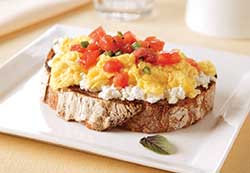 With improved education about the role of eggs in providing valuable nutrients at breakfast, Kanter expects breakfast trends to change. Eggs, after all, are highly functional and can be used in several innovative breakfast food products including breakfast sandwiches, breakfast hot pockets, and breakfast burritos. There are also a variety of opportunities, Kanter says, with eggs for boosting the protein profile of grain products such as waffles and pancakes. In baked goods such as bread, bagels, muffins, and cookies, eggs can help through their natural content of lecithin, which functions as an emulsifier to help slow the onset and rate of firming and extend shelf life. Egg yolks bring the added benefit of their content of lutein and zeaxanthin, naturally yellow, which add color to baked items. Consider new Egg Bagels from Dunkin’ Donuts, Quincy, Mass. (www.dunkindonuts.com), with their characteristic yellow hue that signals freshness and nutrition.
With improved education about the role of eggs in providing valuable nutrients at breakfast, Kanter expects breakfast trends to change. Eggs, after all, are highly functional and can be used in several innovative breakfast food products including breakfast sandwiches, breakfast hot pockets, and breakfast burritos. There are also a variety of opportunities, Kanter says, with eggs for boosting the protein profile of grain products such as waffles and pancakes. In baked goods such as bread, bagels, muffins, and cookies, eggs can help through their natural content of lecithin, which functions as an emulsifier to help slow the onset and rate of firming and extend shelf life. Egg yolks bring the added benefit of their content of lutein and zeaxanthin, naturally yellow, which add color to baked items. Consider new Egg Bagels from Dunkin’ Donuts, Quincy, Mass. (www.dunkindonuts.com), with their characteristic yellow hue that signals freshness and nutrition.
Biscuits a Go-Go
While cereal bars have long dominated in the United States as the on-the-go breakfast food option, breakfast biscuits are increasingly more popular in European countries such as France, Spain, and Italy. Mondelez (formerly Kraft), East Hanover, N.J. (www.mondelezinternational.com), has long been developing its belVita brand of breakfast biscuit in Europe. Now, with the launch of belVita breakfast biscuits under Nabisco, the company is leading the way into creating a new sweet breakfast biscuit category in the United States. Surely, considering current breakfast trends, we can expect more launches in the future on both the sweet and savory side and with new nutritional improvements in terms of protein and fiber.
Fiber Solved
Although sales for cereals have gone, well, pretty cold, companies like Kellogg and General Mills have been doing their part to make them better for you. According to a study published in the June issue of Procedia Food Science, the amount of fiber in breakfast cereals from these manufacturers has increased 32% between 2005 and 2011. In addition, the amounts of sugar and sodium decreased 10% and 14%, respectively. In the study, ingredient sources for fiber other than whole grain included oat fiber, corn bran, inulin or chicory root fiber, and soluble corn fiber. Now other cereal manufacturers are following suit.
ConAgra Mills., Omaha, Neb. (www.conagramills.com), can help with offerings such as Ultragrain® whole wheat flour, and Sustagrain®, the highest-fiber whole grain. These are an ideal base for any grain-based breakfast item including cereals, biscuits, muffins, and breads. According to Don Trouba, Director of Marketing, ConAgra Mills, Sustagrain, milled from a special variety of barley that naturally has the highest fiber content of any whole grain, delivers three times the fiber of oats and 10 times the fiber of brown rice. “Studies have shown that Sustagrain, which has the lowest glycemic index of any grain, promotes satiety and sustained energy, both important benefits when powering through the morning,” he says. “It’s a natural complement to yogurt as a prebiotic, and works extremely well in bars. It’s an all-around superfood, but is particularly useful in heart-healthy items thanks to its high levels of beta-glucan.”
Soluble dietary fibers offered by Fibersol (www.fibersol.com), a joint venture of Archer Daniels Midland Company (ADM), Decatur, Ill., and Matsutani America Co., Japan, can also assist in helping manufacturers reach desired fiber content for fiber claims. According to Käti Ledbetter, Product Development Scientist for ADM, Fibersol can easily increase fiber of a product to achieve a “good source” (2.5 g) or “excellent source” (5 g) claim while having minimal effects on a formulation texture or flavor and supplying fewer sugars and calories per gram.
A full line of prebiotic fibers, soluble fibers, and resistant starches is also available from Ingredion Inc., Westchester, Ill. (www.ingredion.com). The company’s prebiotic fibers include fructo-oligosaccharides and galacto-oligosaccharides, which may have beneficial effects on calcium absorption, digestive health, and the immune system. In addition, the company’s resistant starches are said to help support blood sugar control and weight management. According to Patrick O’Brien, Ingredion’s Bakery Marketing Manager, the company can help manufacturers improve crispiness, crunchiness, and other textural attributes while helping to achieve front-of-pack claims in areas of whole grain, fiber, and bone health.
Horizon Milling, Wichita, Kan. (www.horizonmilling.com), a joint venture of Cargill Inc. and CHS Inc. flour milling, also offers a range of whole-wheat flours with varying amounts of fiber, textures, and flavors. Recently, the company announced findings of a multi-year research program that evaluated the sensory characteristics of whole-wheat flours that drove liking and disliking in customers. With the new information, the company hopes to help customers model the potential impact that certain attributes such as sweet or umami (savory) notes will have on consumers.
A value-added option is the adoption of ancient grains for use in grain-based breakfast products. Earlier this year, Bob’s Red Mill Natural Foods, Milwaukie, Ore. (www.bobsredmill.com), debuted a new line of ancient grains at Natural Products Expo West. The line included several organic varieties such as amaranth, chia, farro, spelt, and kamut that can be used in a range of breakfast applications including breads and cereals.
Breakfast Beginnings
Based on all these new breakfast offerings, you could say that the most important meal of the day itself is getting a restart—as in redefined and refined—with many new convenient, tasty choices. These range from sweet options including Greek yogurt with almonds or walnuts, high-protein breakfast beverages, and yogurt-infused waffles to savory options including dairy-based quiche, meatless sausage patties made with eggs, breakfast sausage on a stick, and pancake sausage bites. Starting the morning right with a nutritious breakfast need not be a childhood memory, and needn’t be so hard or inconvenient. A.A. Milne’s cherished childhood story Winnie-the-Pooh contains within it a short dialogue that can serve as a helpful reminder for how breakfast should really be perceived daily:
“When you wake up in the morning, Pooh,” said Piglet at last, “what’s the first thing you say to yourself?”
“What’s for breakfast?” replied Pooh. “What do you say, Piglet?”
“I say, I wonder what’s going to happen exciting today?” said Piglet.
Pooh nodded thoughtfully. “It’s the same thing,” he said.
Next month’s Ingredients section will focus on ingredients and strategies for formulating sodium-reduced foods.
www.ift.org
Members Only: Read more about ingredients for breakfast foods online at www.ift.org. Type the keywords into our search box at the upper right side of our home page.
David Despain,
a member of IFT,
is a nutritionist and freelance writer based in Gilbert, Ariz.
[email protected].
